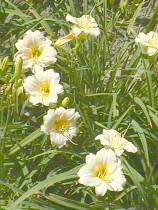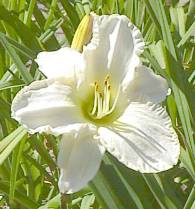
- Ambleside Gardens, Fairport (Melodye Campbell)
- Karla Krogstad, Rochester
- Grace Gardens, Penn Yan (Tom & Kathy Rood)
- Cobbs Hill Daylily Garden, Rochester (Charlie Zettek)

They're cropping up each year in more perennial gardens. You know, daylilies. Maybe you're one of the people calling them tiger lilies (when Lilium lancifolium they're not). Or, like one of my friends, you call any yellow daylily "Stella De' Oro." No problem, you know what you like, by any name. Although not "true" lilies like the bulbous Lilium, daylilies or Hemerocallis are tuberous roots, which put them in a broad botanical group of "bulbs" (geophytes).
As hardy flowering perennials, daylilies enjoy great popularity in many growing zones. A search of the Web reveals over 150 daylily pages, from vendors to proud backyard gardeners sharing pictures of their favorites. The American Hemerocallis Society boasts thousands of members. The number of registered daylily varieties tops 40,000 due to work of professional and amateur hybridizers. There is no lack of interest in the Upstate NY region.
 |
We enjoy several AHS registered display gardens in
the area, including:
|
| Lady Limelight |
The bloom seasons are early, mid-season, and late; there are gradations within each growing zone or micro-climate. In Rochester, the early season yields June blooms, the peak of mid-season is the middle of July, and a late season extends from the end of July to the second week of August. The word Hemerocallis comes from two Greek words meaning "beauty" and "day," due to the fact that each flower lasts only one day. But many buds on multiple scapes produce daily flowers for three to four weeks during the aforementioned seasons.
 |
Seasonality is but one of the factors in describing a daylily variety. There are a number of sizes of plants. Some of the small flowers or color patterns can only be enjoyed close-up. Others are striking enough so that the clump can be at a distance across the yard. In descriptions of varieties, size refers to flowers, so that a "miniature" has a small blossom. But one must also know the size of the scape (stem), given as the height. |
| White Temptation |